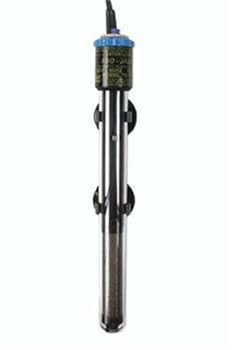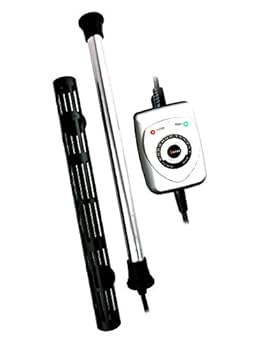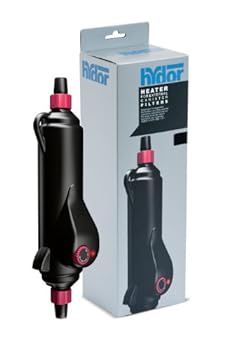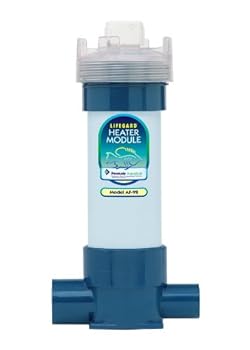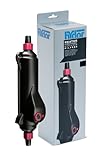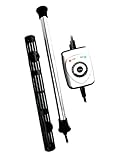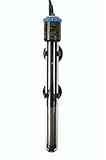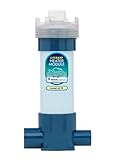Best Aquarium Heaters by Tank Size
Need to keep your water from freezing? Then you need a reliable aquarium tank water heater…
Probably the single most important piece of equipment your tank needs, next to the aquarium filter, is your aquarium heater. But with so many to choose from now, which is the right one for you?
Let’s break this down to the top 3 heaters for your fish tank based on size.
What are the benefits of an Aquarium Heater?
A reliable aquarium water heater can help prevent several parasites from propagating in your tank. Your heater can also help prevent disease caused by fluctuating water temperatures. A drafty window or seasonal weather patterns can cause water in your tank to fluctuate unexpectedly. This can cause stress to your fish, leading to unwanted illness and even the death of your prize fish.
Keeping your tank at steady and constant temperature provides stability for your fish to thrive and even propagate. If you breed fish you know how a simple adjustment of the heater a few degrees down and back up can help fish get into the breeding mood. Also raising the temperature a few degrees can help sickly fish fight off sickness and parasites.
Your heater plays a critical part in the stability and health of your aquarium. So let’s jump into which heater we feel are currently the best on the market for your tank.
Top Aquarium Heaters by Tank Size
We thought it would be easiest to break down the top three aquarium heaters by tank size. This way you can purchase the correct heater for your water volume. No sense in buying an oversized heater for a small ten-gallon tank. Or vice versa, an undersized heater for a larger tank.
Eheim Jager Submersible Aquarium Heater
Great heater by Eheim Jager who has been around a long time. Perfect for small to mid-size aquariums. Precision mounted thermostat and available in several watt ranges.
If you have a small to mid-size tank, you may want to look into Eheim Jager line of aquarium heaters. Made to mount just above the gravel line, below the flow of your filter outlet. Eheim Jager has several watt ranges available for just about every size of tank. If you have a smaller tank, this may be the perfect aquarium heater for you.
Finnex Aquarium Titanium Heater with Guard
Finnex all titanium heater is virtually indestructible. A very nice external precision thermostat control keeps your arm out of the tank. Finnex also gives you a heater guard to protect you and your fish from burns.
Free Shipping Available
If you have a mid-size to a larger tank, you may want to consider the Finnex titanium aquarium heater. It's made of titanium, so it's pretty tuff. All metal design makes this heater very durable. The one key feature is the included aquarium heater guard. When metal heaters first came out, I remember getting burns on my forearm while cleaning. Also, some of my larger fish would sometimes lean against the header and get burnt. Finnex has helped avoid burns by providing a nifty heater guard.
Hydor In Line External Aquarium Heater
If you don't want to fuss with sticking your hand in your tank, getting burned or dealing with broken heaters, the Hydor In-Line External Heater is a very promising unit that neatly hides away under your aquarium cabinet alongside your canister filter.
Free Shipping Available
One more option for the mid-size to a larger tank, they [Hydor In Line External Aquarium Heater](https://tropicalfish.io/store/137/hydor-in-line-ex... is a neat compact heating unit that connects to the outlet of your existing canister filter.
If you don't want to fuss with sticking your hand in your tank, getting burned or dealing with broken heaters, the Hydor In-Line External Heater is a very promising unit that neatly hides away under your aquarium cabinet alongside your canister filter.
Lifegard AF-92 Heater Modules
Lifegard heater module enables you to tuck away your heater out of sight. Some assembly required but made to last. Recommended for larger aquariums.
Free Shipping Available
If you have a larger tank and using a canister filter, you might want to consider using a [Lifegard heater module](https://tropicalfish.io/article/108/lifegard-af92-... Two great benefits of using the Lifegard heater module is efficiency and your heater is out of sight. The Lifegard heater module accepts 3/4" to 1" diameter heaters up to 12" long. The water is pushed into the module by your canister filter and gets heated as it swirls around in the module. Ultimately saving you space and keeping your water heater neatly tucked away.
Types of Aquarium Heaters
Aquarium heaters come in three overall categories, they are internal, hang-on and external or inline. The size of your tank and the needs your tank may require to play a huge role in deciding which is best for your aquarium.
Check Price on Amazon
Free Shipping Available
Check Price on Amazon
Free Shipping Available
Internal: By far the most common of the aquarium heaters, they are typically made of glass and have a thermostat dial on the top of the heater. Commonly mounted with suction cup clips and placed just above the gravel line under the filter to help circulate warm water. Glass models can break if water temperatures fluctuate or a sudden impact. Some internal heaters have external controls, so you don’t have to stick your hand in the tank every time you need to adjust the temperature.
Hang-On: Heaters that hang on typically have a bracket or clip that mounts on the very top of your fish tank. Although most of the heater is submerged, a portion does remain outside of the fish tank, allowing for external thermostat control. Usually made of glass, hang-heater can break if the water level drops too low either by water change or evaporation. Because the heater is mounted on a clip/bracket, bumping could cause the glass heater to knock against the inside tank wall causing it to break.
Inline/External: This is a bit tricky as an external or in-line heater really refers to a container that houses the heater with an inlet and outlet. Most accept both metal or glass heaters and they have external temperature controls. The inline/external heater requires an [aquarium canister filter](https://tropicalfish.io/article/90/best-aquarium-c... to push water through the heater module and back into the tank. A bit neater as both the heater module and canister filter can be tucked away in the aquarium cabinet.
How to Choose the Right Aquarium Heater
Let’s break down some points that will help choose the right heater for your fish tank. Several of them will seem like common sense but we hope that our list below covers some points that perhaps you hadn’t yet considered.
Thermostat Controls: Do you need to fine-tune and get the exact temperature for your fish tank? Or does reading a thermometer in your tank to get a general reading good enough? Some species tank may require more granular control over temperature. If that is the case, several heaters now have external dial controllers with LCD/LED read out to set exact temperatures. Smaller heaters, similar to older models, have a dial with a general range and you just have to trust that it’s right.
Brand: Trust in a brand goes a long way, certain companies have been around a long time. They have spent the dollars and cents to test and create a quality product. This is not to say new companies are not worth trying out. Only that when it comes to making the final decision, we feel that certain brands have set the bar consistently high.
Purpose: You may have a reef tank or a freshwater fish tank, every tank size variant and species needs to have a well thought out plan for equipment. For example, will you need to keep temperatures in the higher ranges? Or does the species of fish you are keeping need very specific temperatures? Will you need the heater mounted inside the tank or outside the tank?
It’s pretty obvious the heater needs to heat the water, when thinking of purpose, ask yourself how will this fit into my overall tank plan.
Size of Tank: No doubt, a larger tank requires more wattage to keep water warm, especially in cooler climates. Picking the right heater for your tank size is critical to the stability and health of your tank. An undersized heater could cost you more in the long run as it will have to stay on longer and shut off fewer times.
An oversized heater runs the risk of potentially burning or killing your fish if the heater gets too hot fast. Although the temptation may be there to go with the overkill mentality, it is best to think of the tank size and pick a heater that will meet your needs.
Material: Newer models now are made of metal versus older models made of transparent or semi-transparent glass. There are positives and negatives to both. Heaters made of glass tended to break or shatter under certain conditions if the heater was exposed to temperature fluctuation. All metal designs tend to cause burns on fish when placed inside the tank.
Budget: In the end, it’s all about the money, for some there is no limit to spending on their fish tank, for others who watch their money a bit closer, maximizing every dollar is critical.
The best way to avoid overspending on an aquarium heater is to know ahead of time watts per gallon/liter required and know if you do need more granular control of temperature settings. These two considerations should help guide you in making a better choice for your aquarium heater.
How does an Aquarium Heater work?
Aquarium heaters work on the simple premise of heating a filament inside either a glass or metal container to a precise or semi-precise temperature range using a thermostat.
It’s really not that much different than what you see inside the glowing light bulb, with the exception of the filament, which is much larger inside the aquarium heater allowing for more heat to be generated.
Old fashioned aquarium heaters are made of transparent or semi-transparent glass that can be mounted with suction cup clips to the inside of your aquarium. The cord usually exits towards the top of the tank with the end being plugged into the wall.
Older glass aquarium heaters had a tendency to break if hit too hard by a tank decoration or other accidental bump. Also if the tank water evaporated leaving a portion of the heater exposed could cause the glass to crack or break.
Lately, new models of aquarium heaters are made of metal, completely sealed, the metal conducts the heat evenly and perhaps better than the old-fashioned glass heater.
Although solving the cracking or breaking of the glass problem, metal heaters do get very hot. Several of my discus fish have been burnt before I eventually moved to an external aquarium heater.
Once the aquarium heater is mounted in the tank with suction cup clips, assuming you have already filled your tank with water, you can now set your thermostat to the specific temperature your tank requires. Some heaters have a dial mounted directly on top of the heater itself. Others have a dial in-line outside of the tank where you can set the temperature.
It is always recommended that you have a thermometer or sensor to keep your aquarium heater honest. Protecting your fish from overheating caused by a faulty heater can be easily done with a quick visible temperature reading. You can purchase a simple sticker, glass thermometer or temperature sensor. In the end, they will all help you get the best use of your aquarium heater.
Aquarium Heater FAQ
What are the temperature ranges?
Generally, aquarium heaters can range from the low to mid 60 degrees all the way up around 90-ish degrees. Depending largely on the manufacturer, those are about the ranges you will find.
What can cause a glass heater to break?
Sudden temperature fluctuation, for example really cold water on a hot heater. Also for hang on models, it is important that tank water not evaporate too low or that can cause the heater to overheat and break.
Does the heater turn on and off on its own?
Yes, heaters sold for aquarium purpose should have auto on and off controlled by an internal sensor. Generally, it’s a set it and forget it type thing, always have a thermometer or other way to double check tank temperature. Not often, but sometimes heater can malfunction and overheat an aquarium.
How many watts do I need for my tank size?
A general rule would be 3 to 5 watts per gallon of water that needs to be heated.
Do I need to stick my hand in the water to change the temperature?
If you purchase an aquarium heater with the thermostat dial mounted on the top of the heater, then yes. If you do not want to be sticking your arm in your tank to adjust temperatures, consider purchasing a heater with external temperature controls.
Does it matter how I mount my heater inside my tank?
Yes, you may want to keep it mounted in the lower third of your tank, just above the gravel or substrate line. You may also place the heater close to the water return from your aquarium filter to allow the incoming water to be heated and circulated throughout the tank.
Should I get an external inline heater?
That all depends on your tank size and filter setup. Most external inline heaters work connecting to the outlet of your aquarium canister filter. In this way, the water is heated as it exits the filter and is pushed by the inline heater. The water is then recirculated warm and clean back into your tank.
Wrapping it all up…
Next, to your aquarium filter, your heater is the most critical piece of equipment in your tank. You are wise to evaluate your options and make sure you are getting the best for your budget and fish tank.
Not all aquariums have the same needs, take a look at both glass and metal options as well as internal and external heaters. Depending on the type of tank or species your keeping, you may have special needs to take into consideration.
Either way, your aquarium heater will play a very important role in the stability and health or your aquarium.
Have a Tropical Fish Question?
Join our tropical fish community, post some questions, get some answers and vote for the best posts.
